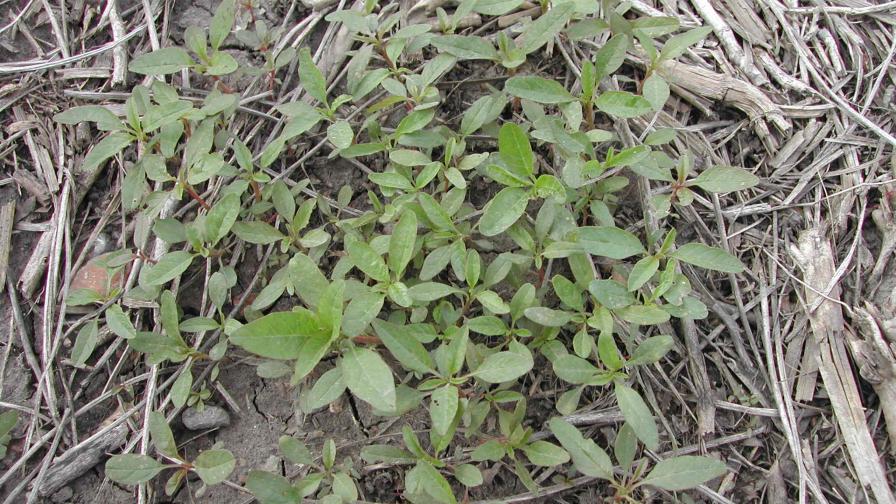For Weeds, Resistance is Not Futile

Waterhemp in Illinois has now appeared resistant to six herbicide modes of action.
In mid-February weed scientists in Central Illinois discovered something truly frightening lurking in a pair of crop fields in McLean and Champaign counties — populations of waterhemp that were resistant to the Group 15 herbicides (long-chain fatty acid inhibitors). This group includes such popular active ingredients (AIs) as S-metolachlor, acetochlor, pyroxasulfone, and dimethenamid-P.
By its nature, waterhemp has become one of the poster children among weed species for its ability to develop resistance to multiple herbicides. In fact, with this latest population’s discovery, waterhemp in the states of Illinois and Missouri have confirmed resistance to ALS inhibitors, HPPD inhibitors, atrazine, PPO inhibitors, dicamba, 2,4-D, and glyphosate.

Jim Lappin
According to Jim Lappin, Marketing Manager for Corn, Soybeans, and Sugar Beets, AMVAC Chemical Corp., this variety of waterhemp is just the latest in a long list of herbicide-resistant weeds now overcoming multiple modes of action in the marketplace. “Growers and ag retailers need to understand how quickly these weed pressures are expanding,” Lappin says. “Given the state of things right now in weed resistance, any newfound resistance could be important.”
Dawn Refsell, Manager, Field Development, Midwest Commercial Unit, Valent U.S.A., agrees. “Today the waterhemp resistant to the Group 15 herbicides is only in a few fields in Illinois,” Refsell says. “But without any precautions on the part of growers, it could very easily become much more widespread very, very quickly.”

Eric Ifft
Perhaps most troubling for agriculture regarding these waterhemp populations, says Eric Ifft, Customer Business Advisor, Bayer CropScience, is the fact that the resistance being demonstrated doesn’t involve a binding site or altered target site; it is metabolic. This means that the weed is utilizing three key enzymes — cytochrome P450, glutathione S-transferases, and aryl acylamidase — to break down/detoxify the herbicide being applied to it.
“Metabolic resistance is the most serious kind of herbicide resistance in the market because once a plant can metabolize a chemical, that’s hard for any type of control measure to overcome,” Ifft says. “About the only way to get around this kind of resistance is for the grower to use a pre- and post-application, using multiple sites of action. Otherwise, the weed will just keep growing.”

Drake Copeland
Weedy Wonders
Since the first glyphosate-resistant marestail was confirmed in a Delaware crop field in 2001, all manner of herbicide-resistant weeds have spread out across America. In fact, according to Drake Copeland, Technical Services Manager, FMC Corp., there are more than 90 different weed species in the country today that have confirmed herbicide resistance to at least two modes of action. “The U.S. leads the Earth in herbicide-resistant weed types,” Copeland says.
Even more importantly, he adds, research studies have shown that resistant weeds tend to produce more seeds per plant than their non-resistant counterparts. And these seeds tend to spread very far and wide. “Recently, researchers used some unmanned drones to seek out weed seeds in the skies above crop fields to study the impact of wind movement on them,” he says. “They found seeds from horseweed plants that were present between 230 feet and 460 feet above the ground, which means they could travel very far between one field and the next.”
Another way resistant weeds can quickly move across the landscape is through what could be called “inter-species breeding.” As Copeland explains, many growers have in recent years noticed an increase in the number of Palmer amaranth and waterhemp plants that are resistant to herbicides. In many cases, the preferred control method to deal with these is to hand-weed the female plants out of the field while leaving the male plants alone to prevent seed production.
This might not be a foolproof method of weed control, however. “Field studies have demonstrated that pollen plays an important role in dispersing herbicide-resistant alleles in dioecious weed amaranthus species,” Copeland says. “Researchers have discovered that resistant traits can be dispersed from male waterhemp plants to female Palmer amaranth plants.”

The Helm Agro U.S. crew at Commodity Classic: (from left) Jan Stechmann, James Whitehead, and Adam Hensley.
In addition to spreading naturally, many herbicide-resistant weeds might unwittingly receive a hand from the growers themselves, who try to control them with herbicides after the recommended label height language. “Growers underestimate the size of their weeds all the time and spray them when they are too tall,” says James Whitehead, Agronomy Leader, Helm Agro U.S. “Usually, any weeds taller than 4 inches — about the size of a credit card — probably can’t be controlled with spraying and might survive the attempt to become resistant later on.”
The final way herbicide-resistant weeds have managed to spread across the nation’s crop fields is that many in the agricultural community are of the belief that new AIs “are just around the corner.” However, according to Dr. Dan Waldstein, Technical Marketing Manager, BASF, this isn’t true.
“Whenever we have broken one of the industry’s chemistries in the past, everyone always says ‘the chemical companies will come up with a new solution,’” Waldstein says. “But I’m here to say that the last new mode of action we saw come into the market was back in the 1990s, and in the current regulatory environment regarding new chemistries, a new one isn’t going to come along very quickly, even if we had one to introduce.” Given the current state of AI development, he adds, it could be “another six or seven years” before a new mode of action herbicide would hit the market.

Dan Beron
The Cocktail Approach
To combat the growing list of herbicide-resistant weeds already in the market, crop protection suppliers in recent years have adopted what could be called a “cocktail” approach when it comes to product development. This involves blending two or more AIs with different modes of action to control resistant weeds.
For example, Nufarm Americas offers users Panther Pro herbicide. Panther Pro combines three different AIs in its mix — metribuzin, flumioxazin, and ammonium salt of imazethapyr — that each feature a different mode of action. “Panther Pro can be used to control more than 60 broadleaf weeds and grasses in soybeans,” says Dan Beron, Technical Service Director. “This includes glyphosate-resistant common ragweed, common waterhemp, and horseweed.”
Another such “cocktail product” is Fierce MTZ from Valent. A blend of three AIs (flumioxazin+pyroxasulfone+metribuzin), Fierce MTZ can help control Palmer amaranth, common waterhemp, common and giant ragweed, and kochia for up to eight weeks, says Dr. John Pawlak, Product Development Manager. “With weed control being a key hurdle year after year, we continue to recommend using multiple effective modes of action in weed management systems,” Pawlak says.
New for the 2019 growing season, Helm has introduced Zone Elite herbicide for soybeans. Featuring two AIs — sulfentrazone+metolachlor — Zone Elite is a preemergence herbicide that can be used to control 45 different weed species, including waterhemp, foxtail, and amaranthus species. “For growers battling resistance, Zone Elite is an ideal weed control solution,” says Jan Stechmann, President. “With two modes of action plus 45 to 60 days of residual activity, Zone Elite keeps early-season soybean fields clean for longer periods — allowing more flexibility for post-emergent applications.”
Of course, one of the newest methods for dealing with herbicide-resistant weeds has been the introduction of new cropping systems tied to key herbicide applications. Since 2017 dicamba-resistant crops have entered the marketplace and have become an important tool for battling resistant weeds across the country. Several crop protection product suppliers, including Bayer, BASF, and Corteva, currently have dicamba herbicides that can be used with these crops.

Bobby Bachman
Syngenta is now looking to get in on the game, with a slight twist. According to Bobby Bachman, Herbicide Product Lead, the company hopes to add its new dicamba offering, Tavium, to this mix very shortly. “We are currently awaiting regulatory approval for Tavium, but we expect it to happen over the next couple of months,” Bachman says. “What makes Tavium different is it isn’t only dicamba. It contains two active ingredients, dicamba and S-metolachlor, to offer residual control on such hard-to-manage weeds as Palmer amaranth, velvetleaf, and waterhemp.”

Haley Nabors
Looking to 2020
While Tavium will target the current dicamba cropping system, 2020 should see plenty of activity in the other major cropping system that’s been teased these past few years — 2,4-D-resistant crops, headlined by Enlist from Corteva AgriScience. In development for several years, Enlist crops are tolerant to the 2,4-D choline technology available in Enlist Duo and Enlist One herbicides. Enlist E3 soybeans also have tolerance to glyphosate and glufosinate.
This could help growers deal with some of the hardest-to-control broadleaf weeds, including Palmer amaranth, waterhemp, and giant ragweed. According to Haley Nabors, New Technologies Specialist, Corteva, Enlist 3 soybeans haven’t been widely available until now because the company was waiting for import approval from China. “We finally received this import authorization this past January,” Nabors says.
Going forward, Nabors says Corteva will begin offering E3 soybeans to U.S. growers in 2019 on a “limited basis,” with a more widespread launch coming for the brand in 2020. “Overall, we anticipate E3 soybeans to represent approximately 10% of the soybean acres in the U.S. come next year,” she says.
Speaking of next year, several industry insiders that spoke with CropLife® magazine were asked what weed species should bear watching for signs of resistance during the 2019 and 2020 growing seasons. Some mentioned that herbicide-resistant Russian thistle (salsola tragus) has already been documented in parts of the Pacific Northwest, with some plants reportedly surviving up to 128 ounces of glyphosate applications. The species has been spreading in the region since 2015.
Of course, many weed watchers recommend growers and ag retailers keep their eyes on new developments with the usual suspects among herbicide-resistant weeds — waterhemp, Palmer amaranth, ragweed, velvetleaf, etc. However, besides broadleaves, industry insiders say watching out for herbicide resistance among grass species has also been a concern.

Dawn Refsell
“Personally, I’m very nervous about the ability of some grasses to start showing resistance,” Valent’s Refsell says. “This kind of evolution has already happened in other parts of the world for Johnsongrass and Italian rye grass, so it could happen in the U.S., too.”
BASF’s Waldstein agrees with Refsell that grasses should be monitored closely for herbicide resistance in 2019 and beyond. “I would pay particular attention to barnyard grass,” he says. “I’ve already heard rumors that some species of this grass are showing resistance to glyphosate. A resistant grass species like this could be a real gamechanger for the entire weed control market.”

Dan Waldstein
For the foreseeable future, Waldstein says that the agriculture industry will need to remain proactive rather than reactive when it comes to applying today’s herbicides to crop fields. “Growers really need to manage the effective tools they currently have in the herbicide toolbox,” he says. “There might be some new tools coming eventually, but right now these are many, many years away.”
Besides better management of existing herbicides, Ryan Hunt, Technical Services Manager for FMC, says that growers should also alter the way they deal with known weeds on their properties. “The weed-resistance problem is getting worse every year, in part because of poor management decisions,” Hunt says. “Growers need to adopt a zero-tolerance policy and not allow any weeds to remain in the field. And if it’s more than 4 inches tall, it should be removed by hand instead.”
Helm’s Whitehead concurs with this view. “The industry needs to stick with the full-label usage information when handling weeds,” he says. “The herbicide-resistant weed problem is already bad. But if we keep doing things the way we’ve been doing them for the past few years, you will definitely see the problem get a whole lot worse!”







